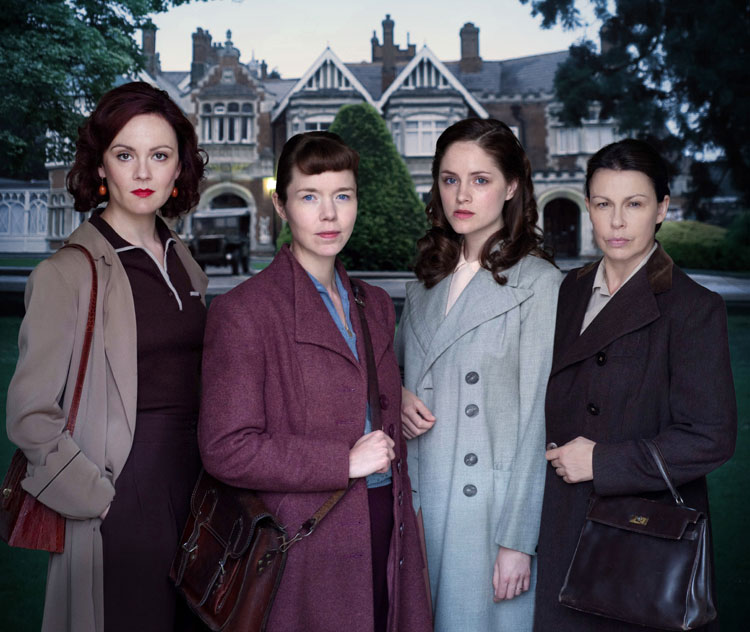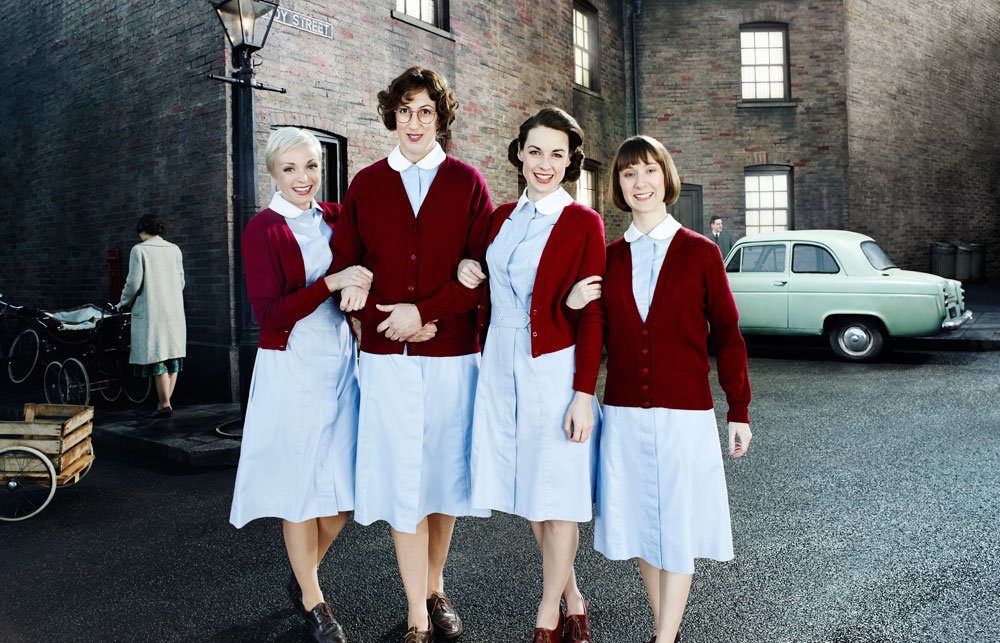Helen George, Miranda Hart, Jessica Raine, and Bryony Hannah in PBS’ Call The Midwife
One of the questions we get asked most often, when it comes to our TV coverage is “Why don’t you write about this show?” And it’s usually a show which is written about plenty by other people (like Game of Thrones, for example). Our answer always comes down to “If we can’t find a way to say something new and/or interesting about this show, then we don’t see the point in writing about it.” The TV recapping and reviewing landscape is so vast now, with so many voices populating it. If we expand our TV coverage, then we’d rather take the time to look at the shows people aren’t writing enough about.
Both Call the Midwife and The Bletchley Circle were shows that our readers told us about. We doubt we would have discovered them otherwise because, frankly, PBS is terrible about promoting its own shows. We can’t recall when we were told about them or what was said. We just had a vague memory of the titles of each show sticking in our heads and when we encountered them both on Netflix streaming, we queued them up for a watch. We were hooked on both shows instantly, even though they couldn’t be more different from each other. That might seem odd to say, since one show deals with women in 1950s London and the other show deals with … women in 1950s London, but it serves as a great example of how the same setting (and even some of the same themes) doesn’t always mean you’re going to get the same story. It all comes down to the goals of the creators.
After we watched the very first episode of Call the Midwife, Tom turned to Lorenzo and asked, “How is it that this show isn’t talked about in my family constantly?” Tom has four sisters, all of whom were educated by nuns, all of whom are mothers, two of whom are nurses and one of whom worked for some time as a social worker serving under-privileged families. Call the Midwife is a show about nuns and nurses in the East End of London, helping underprivileged women through their pregnancies and births. “It’s like a TV show version of half the conversations my sisters have with each other.”
There’s something of the old school in Call the Midwife. The basic plot of each episode is largely the same: one of the midwives (who all live together) has a personal crisis while another midwife encounters a patient who’s going through a personal crisis. By the end of each episode, most crises are resolved in some way. It’s very “Touched by an Angel.” Except not. You’d think a show like this would be awash in sentimentality, but not only does it never flinch away from showing the truth of what poverty looks like and what it does to families, it has some of the most brutal birth scenes ever depicted on television. Note we didn’t say “graphic.” We just mean that we’ve never seen birth depicted in such a, shall we say, down to earth way. When even we find ourselves pushing, then you know they’re doing a fantastic job of putting you in the moment.
But past all the trappings of motherhood and religious devotion (and even the occasional hilarious-to-an-American mid-scene speech about how wonderful the National Health Service is), it’s largely a story about the sisterhood of women. And if even that sounds treacly and too broad to be interesting, it illustrates that point by throwing together the widest range of women we’ve ever seen on one TV show; young women, middle-aged women, old women, poor women, wealthy women, shy women, bold women, smart women and even ignorant women and women suffering from dementia. The sheer range of types and experiences are what makes the show what it is; that, and the camaraderie and relationships that develop among all these characters. It’s mostly a gentle show, with most conflicts resolved rather easily. We wouldn’t claim it was challenging to watch, but it’s definitely rewarding.
And Chummy alone is worth it. There’s simply no other woman on TV quite like her.
 Rachael Stirling, Anna Maxwell Martin, Sophie Rundle, and Julie Graham in PBS’ The Bletchley Circle
Rachael Stirling, Anna Maxwell Martin, Sophie Rundle, and Julie Graham in PBS’ The Bletchley Circle
The Bletchley Circle, on the other hand, is both challenging and rewarding, but in a different way. And while the range of women depicted on the show is narrower than Call the Midwife (and tends to fall into Sex and the City-style tropes of “the married one,” “the sexy one,” “the naive one,” and “the mature one”), it celebrates something very rarely celebrated on television: the truly brilliant woman. Even better, it does so by reminding you that there’s more than one kind of smart woman out there.
The premise is simple to the point it almost sounds like a parody of a British TV show: Four women in 1950s London, a decade after the war, come back together to solve the murders of women. But these are no fumbling amateurs. They’d spent the War working as code breakers in the famous Bletchley Park and now, since they’ve been sworn to secrecy about their work, are forced to go through the limited motions available to women in the 1950s, their keen analytical minds undimmed, their frustration with the world for not recognizing them growing by the moment. That’s the hook. Some of them got married, some had kids, some traveled the world and some kept working. Each and every one of them felt stymied and unsure of whether they even had the right to feel that way. The only other things you need to know are that all the leads are wonderful in their roles and that the moodiness and atmosphere of each episode is off the charts.
But if you want to know even more, there’s this, which we truly love: These women all have a very strong bond and support each other fiercely, but – and this distinction is powerful – they’d probably not be friends otherwise. You look at the leads in Call the Midwife and you can believe they’d all be best girlfriends no matter what. You look at the four women in the Bletchley Circle; four independent-minded, frustrated, occasionally prickly women who aren’t always easy to deal with – and you don’t exactly picture them all going to brunch to talk about boys. In fact, we’d swear Anna Maxwell Martin, who’s doing an amazing job with the ostensible lead character Susan, is playing her as someone on the autism spectrum, which is a pretty revolutionary way to depict a female protagonist. She’s difficult and sometimes comes across cold, but she has a stunning ability to collect information and find patterns in it. She’s more or less what Benedict Cumberbatch’s Sherlock Holmes would be if he got married, had children, and was taught to know his place. Your initial impression is that she’s shy and mousey, but to your delight, as you get to know her, you realize that what you took for shyness was in fact a long simmering impatience with the rest of the world for not being as smart as she is. She’s fascinating to watch. But they all are, in their own way. Our second favorite is Jean, the no-nonsense mature one who never left government employment and now has a stack of inside contacts as long as her arm; a secret sisterhood of women in mostly clerical work, who all saved lives during the War solely by being brilliant and now nod at each other in silent recognition as they pass in the hallways.
Also? And the above picture does not give one this impression: awesome outerwear. Seriously, those English ladies sport some coats. And like the good little costume queens we are, we paused Sunday night’s episode just to get a good look at each one and to note how each coat is different and tells you something about the character.
Neither show really lends itself to recapping from week to week, but you can consider them T Lo -recommended. They’re both on Sunday nights on PBS and their earlier seasons are available on Netflix streaming. If you think TV has a limited idea of who women are, these two shows do a nice job of countering that; offering depictions of women you rarely get to see.
[Photo Credit: Courtesy of ©Laurence Cendrowicz/World Productions, Courtesy of Jonathan Ford/©Neal Street Productions 2013]
“The Other Woman” Sydney Photocall Next Post:
Dane DeHaan in Prada at “The Amazing Spider-Man 2: Rise Of Electro” Rome Premiere
Please review our Community Guidelines before posting a comment. Thank you!


